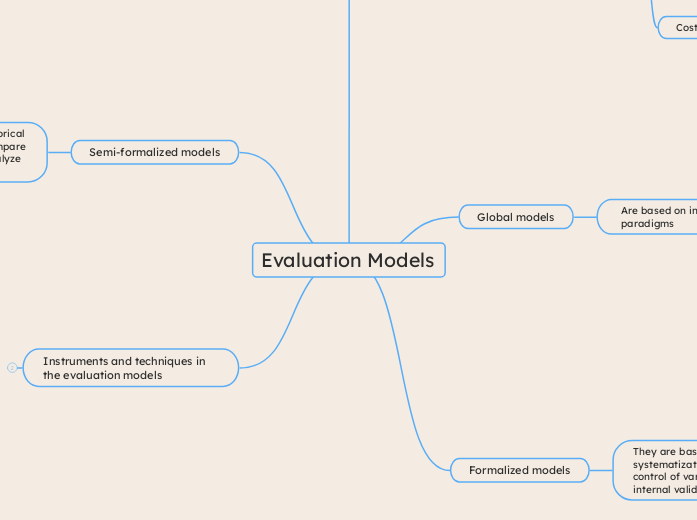Evaluation Models
Analytical models
It is related to epistemological and explanatory paradigms.
Provides explanation based on related theories
Studies observable phenomena
Scientific credibility is based on internal validity.
Uses quantitative information
Follows the deductive method
Privileges statistical analysis
Uses measurement instruments such as the survey
Establishes rules of behavior
In the models are
Cost-benefit
It is based on the quantification and comparison of updated costs and benefits.
Comparison, indicators such as VAN, TIR, among others, emerge.
Cost effectiveness
Evaluates whether the project generates real effects on the target population, beyond the economic benefit.
Selects the most economically efficient alternative, comparing unit or total costs for the same benefit.
Global models
Are based on interpretive paradigms
Among them we can distinguish
CIPP Model
Provide useful information at all stages of the project.
Evaluated from planning to final results
Focused utilization model
Involve leaders and users of information throughout the process.
Choose methods according to utility
Illuminative evaluation model
Describes how the actors live and interpret the project
Fits the meanings that emerge during the evaluation
Expert evaluation model
It is based on the evaluator's accumulated experience and critical sensitivity.
Uses concepts such as referential adequacy and structural corroboration
Formalized models
They are based on the systematization and rigorous control of variables and seek internal validity and replicability.
Among them we can distinguish
Experimental Model
The evaluator manages the experimental conditions
Uses an experimental group and a control group in closed settings e.g. hospitals, schools, etc.
Quasi-experimental Model
No random selection of groups
Comparable but not equivalent groups are worked with
Regression Model
Use statistical techniques to control variables
Requires a robust database and a sound theoretical model
Semi-formalized models
They seek to observe the historical behavior of variables and compare them with the project and analyze changes over time
These include
Non-experimental before and after model
A variable is measured before and after the intervention
If there is no previous measurement, it can be estimated with retrospective questions.
Model after with comparison group
No baseline, but comparison with another group or parallel intervention.
Independent variables are statistically controlled at the end of the project.
Model after
Only what happened after the project is recorded, without prior measurement
Aplicable a proyectos comunitarios, ONG o gobiernos locales donde no hay línea de base.
